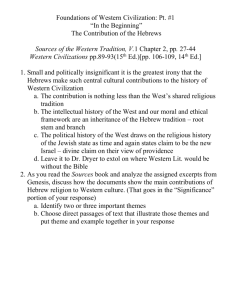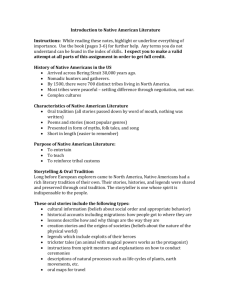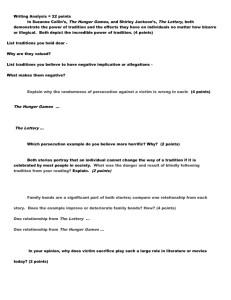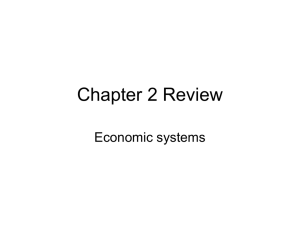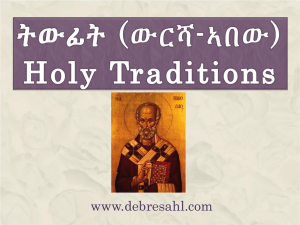WHO IS IN CHARGE 1
advertisement
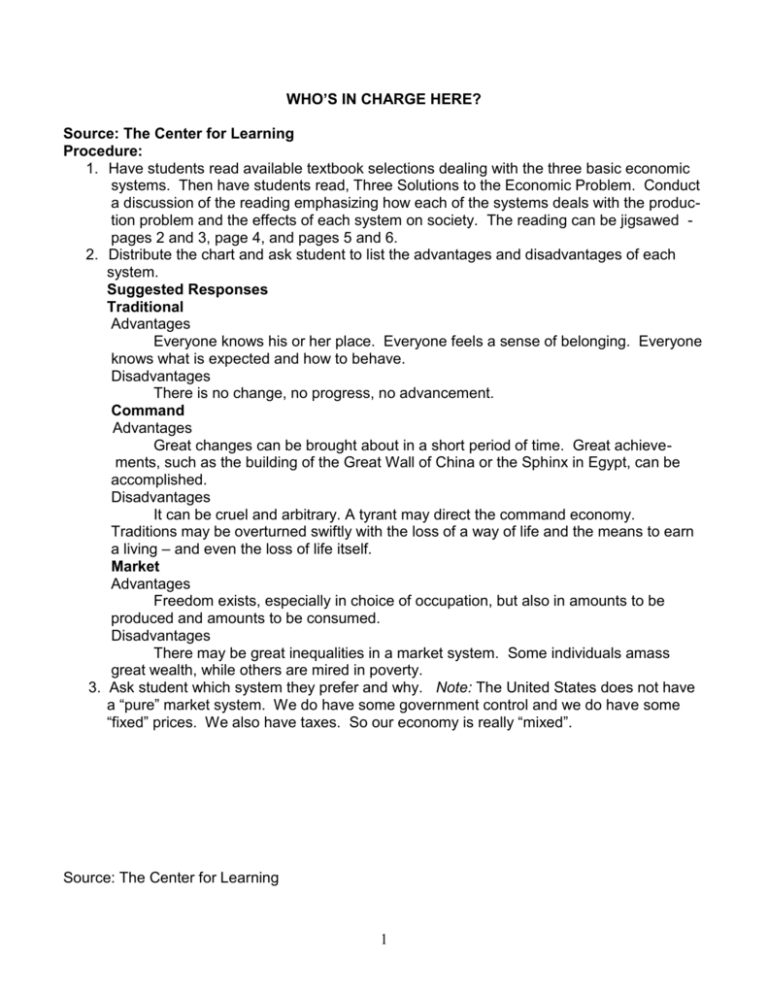
WHO’S IN CHARGE HERE? Source: The Center for Learning Procedure: 1. Have students read available textbook selections dealing with the three basic economic systems. Then have students read, Three Solutions to the Economic Problem. Conduct a discussion of the reading emphasizing how each of the systems deals with the production problem and the effects of each system on society. The reading can be jigsawed pages 2 and 3, page 4, and pages 5 and 6. 2. Distribute the chart and ask student to list the advantages and disadvantages of each system. Suggested Responses Traditional Advantages Everyone knows his or her place. Everyone feels a sense of belonging. Everyone knows what is expected and how to behave. Disadvantages There is no change, no progress, no advancement. Command Advantages Great changes can be brought about in a short period of time. Great achievements, such as the building of the Great Wall of China or the Sphinx in Egypt, can be accomplished. Disadvantages It can be cruel and arbitrary. A tyrant may direct the command economy. Traditions may be overturned swiftly with the loss of a way of life and the means to earn a living – and even the loss of life itself. Market Advantages Freedom exists, especially in choice of occupation, but also in amounts to be produced and amounts to be consumed. Disadvantages There may be great inequalities in a market system. Some individuals amass great wealth, while others are mired in poverty. 3. Ask student which system they prefer and why. Note: The United States does not have a “pure” market system. We do have some government control and we do have some “fixed” prices. We also have taxes. So our economy is really “mixed”. Source: The Center for Learning 1 Three Solutions to the Economic Problem The economist has a different view of society than most people. Underneath the problems of poverty or pollution or inflation, the economist sees a process at work. He must understand “the process.” “The process” is society’s basic mechanism for survival, a mechanism for accomplishing the tasks of production and distribution of goods and services. The economist sees something else as well. Something that seems quite astonishing. Looking over the diversity of current societies, as well as over the sweep of history, the economist sees that mankind has used only three ways to solve the production and distribution problems. That is the economist divines only three overarching types of systems that separately or in combination enable people to solve the economic challenge. These great systems can be called economies run by Tradition, economies run by Command, and economies run by the Market. Tradition Perhaps the oldest and, until a very few years ago, by far the most prevalent way of solving the economic challenge has been tradition. It is a society in which both production and distribution were based on methods devised in the past. They have been tested by trial and error and are maintained by the forces of custom and belief. They deal with the production problem – the problem of making certain that necessary tasks are done – by assigning sons the same jobs as their fathers. A hereditary chain assures that skills will be passed along and jobs will be staffed from one generation to the next. In ancient Egypt, wrote Adam Smith. “. . . every man was bound by a principle of religion to follow the occupation of his father.” If a man changed his occupation it was thought of as a horrible sacrilege. In Western culture, until the fifteenth or sixteenth century, tasks were hereditary. Birth usually determined a person’s role in life. A person was born to either farm or work at a trade. There was some movement from country to town and sometimes, from one occupation to another. Tradition was a stabilizing force and made certain that the work that needed to be done would be done. It would be done very much as it had been done in the past. Today, in less industrialized countries, tradition continues to play a large organizing role. In India, for example, until very recently, a person was born to a caste that had its own occupation. Tradition also helps regulate the distribution problem. The Bushmen of the Kalahari Desert in South Africa depend on their hunting abilities. Elizabeth Marshall Thomas wrote this description of how tradition solves the problem of distributing the kill: The animal has vanished . . . Gai owned two hind legs and a front leg. Tsetchwe had meat from the back, Ukwane had the other front leg, his wife had one of the feet and the stomach, the young boys had lengths of the intestine. Twikwe had received the head and Dasina the udder. It seems very unequal when you watch the Bushmen divide the kill, yet it is their system, and in the end no person eats more than the other. That day Ukwane gave Gai still another piece because Gai was his reLation, Gai gave meat to Dashina because she was his wife’s mother 2 . . . No one, of course, contested Gai’s large share because he had been the hunter and by their law that much belonged to him. No one doubted that he would share his large amount with others, and they were not wrong, of course; he did. The way tradition divides goods and services can be ingenious but it can also be very crude. Usually women in nonindustrialized countries receive only a very small amount. Even though it is different from what we think is right, it is still a workable method of dividing society’s goods and services. Traditional solutions to the economic problems of production and distribution are most commonly found in primitive farming or nonindustrial societies. Yet even in our country tradition plays a part in solving the economic problem. It can be found in payments such as tips to waiters, allowances to children, or work bonuses. Another traditional element is the difference in pay between men and women for equal work. Now we must note one very important consequence of tradition. Its solution to the problems of production and distribution is an unchanging one. A society that follows the path of tradition does so at the expense of large-scale, rapid social and economic change. Therefore, the economy of a Bedouin tribe or a Burmese village is in few respects changed today from what it was a hundred or even a thousand years ago. Most of the people living in traditional societies repeat in their daily economic live much of the routine that characterized them in the distant past. Most change in those societies comes from outside events – war, climate, political adventures. 3 Command A second manner of solving the problem of production and distribution is also very old. This is the method of authority or command. It is the organization of a system according to the orders of an economic commander-in-chief. We frequently find this authoritarian method of economic control on a traditional social base. Egypt had a traditional agricultural society. On top of this the pharaohs ordered the enormous economic effort that built the pyramids, the temples, and the roads. The Greek historian, Herodotus, described how the pharaoh Cheops organized the building: He ordered all Egyptians to work for him. Some, were appointed to draw stones from the quarries in the Arabian mountains down to the Mile, others he ordered to receive the stones when transported in vessels across the river. The method of authoritarian economic organization wasn’t only found in Egypt. It could be found in classical China which produced the Great Wall, or in the slave labor which produced many of the great public works of ancient Rome. Today it can be found in the dictates of communist economic authorities. It can also be found in our own society for example, in the form of taxes. Economic command, like tradition, offers solutions to the twin problems of production and distribution. In times of crisis, such as war or famine, it may be the only way a society can organize its manpower or distribute its goods effectively. Even in America, we commonly declare martial law when an area has been devastated by a great natural disaster. During those times we may requisition homes, impose curbs on the use of private property such as cars, or even limit the amount of goods a family may consume. Unlike tradition, the exercise of command doesn’t necessarily slow down economic change. The exercise of authority can be the most powerful instrument society has for enforcing economic change. Authority in modern China or Russia has brought about drastic changes in the systems of production and distribution. Even in our society, it is sometimes necessary for economic authority to intervene in the normal flow of economic life to speed up or bring about change. The government may undertake an irrigation system that will dramatically change the economic life of a vast region. It may dramatically change the distribution of income among social classes. Economic command that is done within the framework of a democracy is very different from that exercised by a dictatorship: There is a large difference between a tax system controlled by Congress and outright labor impressments by a supreme and unchallengeable ruler. In both cases, command diverts economic effort toward goals chosen by an authority. It interferes with the existing order of production and distribution, to create a new order ordained from “above.” It is important to note that no society – certainly no modern society – is without its elements of command just as none if without the influence of tradition. Both have their uses and their drawbacks. Between them, tradition and command have accounted for most of the long history of man’s economic efforts to cope with his environment and with himself. 4 The market: There is also a third solution to the economic problem. This is the market organization of society. It allows society to insure its own production and distribution with a minimum of recourse to either tradition or command. Assume for a minute that we could act as economic advisers to a society that had not yet decided on its method of economic organization. Suppose, for instance, that we were asked to act as consultants to one of the new nations emerging on the continents of Africa or Asia. We could imagine the leaders of such a nation saying, “We have always had a highly tradition-bound way of life. Our men hunt and farm. They do the jobs as they are brought up to do by the force of example and the teaching of their elders. We know, too, a little of what can be done by economic command. We are prepared, if necessary, to sign an edict making it mandatory for many of our men to work on community projects for our national development. Tell us, is there any other way we can organize our society so that we can function successfully – or better yet, more successfully?” Suppose we answered, “Well, there is another way. One can organize a society along the lines of a market economy.” “I see,” say the leaders. “What would we then tell people to do? How would we assign them to their various jobs?” “That’s the very point,” we answer. “In a market economy, no one is assigned to any job. In fact, the main idea of a market society is that each person is allowed to decide for himself what to do.” There is concern among the leaders. “You mean there is assignment of some men to farming and some to mining? No manner of designating some for transportation and others for weaving? You leave this to people to decide for themselves? But what happens if they do not decide correctly? What happens if no one volunteers to go into the mines, or if no one offers himself as a bus driver?” “Relax,” we tell the leaders, “none of that will happen. In a market society, all the jobs will be filled because it will be to people’s advantage to fill them.” The leaders accept this with uncertain expressions. “Now look,” one of them finally says, “let us suppose that we take your advice and allow our people to do as they please. Let’s talk about something specific, like cloth production. Just how do we fix the right level of cloth output in this “market society” of yours?” “But you don’t,” we reply. “We don’t! Then how do we know there will be enough cloth produced?” “There will be,” we tell him. “The market will see to that.” “Then how do we know there won’t be too much cloth produced?” he asks. “Ah, but the market will see to that too!” 5 “But what is this market that will do these wonderful things? Who runs it?” “Oh, nobody runs the market,” we answer. It runs itself. In fact there really isn’t any such thing as “the market.” It’s just a word we use to describe the way people behave.” “But I thought people behaved the way they wanted to!” “And so they do,” we say. “But never fear. They will want to behave the way you want them to behave.” “I am afraid,” says the chief of the delegation, “that we are wasting our time. We thought you had in mind a serious proposal. What you suggest is inconceivable. Good day.” Could we seriously suggest to such a new nation that it try a market solution to the economic problem? How does the market system assure us that our mines will find miners, our factories workers? How does it take care of cloth production? How does it happen that in a market-un nation each person can do as he wishes and, that all the needs of society will be taken care of? A society that solves its economic problems by the market process is especially interesting to an economist. Many, although not all, of the problems we encounter in America today have to do with the workings or misworkings of the market system. From: The Making of Economic Society, Robert Heilbroner 6 Complete the chart using information from class discussion and reading. Advantages Disadvantages Market Command Traditional Economic System 7

